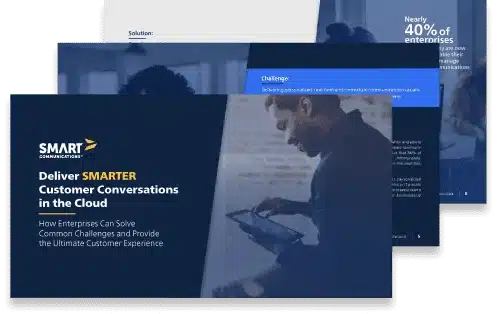Is Legacy CCM a Hidden Liability in Your Enterprise CX Stack?

By Scott Draeger, SVP of Product Marketing and Vertical Solutions at Smart Communications
In today's digital transformation landscape, organizations continue to rely on Customer Communications Management (CCM) implementations that predate smartphones. The recent 2025 SPARK Matrix™: Customer Communication Management (CCM) from QKS Group highlights the risks of keeping legacy CCM technology in production past its useful life.
The report compares Smart Communications’ cloud-native architecture against competitive offerings; “unlike legacy CCM solutions that rely on containerized deployments, this platform is designed with microservices, enabling dynamic scalability and optimized resource utilization.” Ultimately, operating your legacy CCM technology past its useful life risks both new and existing customers at a time when customer experience (CX) is critical to customer acquisition and retention.
These once-effective deployments struggle to meet today’s expectations for agility, personalization, and seamless customer experiences—creating business risk as technology gaps widen.
What Are the Architectural Limitations of "Containerized Deployments?"
Many legacy CCM vendors boast about “moving to the cloud” in marketing materials and RFP responses. When you look deeper, their cloud-moves are “too little too late” as legacy vendors deliver containerized deployments of legacy technology in an attempt to look current. At Smart Communications, we refer to these as “SOSIAC" solutions for short, as they are the “Same Old Software in a Container.” Upon further examination, during an RFP process or evaluation, CCM buyers discover these offerings lack the flexibility and scalability inherent in cloud-native offerings like SmartCOMM™.
SmartCOMM delivers the standards of today and tomorrow. According to QKS’ SPARK Matrix for CCM, Smart Communications has a “modern cloud-native architecture, allowing enterprises to scale communications efficiently without infrastructure constraints." While legacy vendors attempt to modernize through incremental updates and SOSIAC-solutions, SmartCOMM leverages "microservices, enabling dynamic scalability and optimized resource utilization” according to the report.
The SPARK Matrix highlights the benefits of Smart Communications’ cloud-native architecture:
“The availability of an API-driven architecture ensures flexibility in deployment, enabling organizations to connect their communication workflows to external data sources, automation tools, and business intelligence platforms. This approach supports a composable enterprise strategy, where organizations can extend their customer communication capabilities without significant IT dependencies.”
Evidently, legacy CCM platforms are on the wrong side of an expanding capability gap.
How Do Silos Fragment Customer Experience?
Legacy CCM solutions encourage what QKS identifies as silos within communication channels. These silos are created by disconnected systems that force teams into redundant template creation in a channel-by-channel approach. This approach makes consistent, cross-channel messaging nearly impossible while adding cost and risk. Inconsistent messages drive outcomes that inspire confusion, create inbound calls, and—in extreme situations—drive customer churn.
QKS’ 2025 SPARK Matrix agrees, stating that “[SmartCOMM] eliminates the silos commonly found in traditional CCM systems, where different communication types require separate workflows. By allowing real-time adjustments across digital and print channels, Smart Communications ensures consistency in messaging without requiring redundant template creation.” SmartCOMM’s approach eliminates the fragmentation that increasingly frustrates today's customers.
What Are the Costs of Delayed Modernization?
Every quarter that your organization postpones the decommissioning of legacy CCM represents measurable opportunity costs. While "restructuring existing templates, workflows, and data models to align with a SaaS-based architecture requires extensive planning," the alternative of maintaining data access, security, design consistency, and integrations between increasingly outdated systems is costing you more than you think. Delaying your digital transformation creates quantifiable, competitive disadvantages in customer satisfaction, operational efficiency, and market responsiveness.
Conclusion
The recent perspectives from QKS suggest that legacy CCM is approaching an inflection point where maintaining these systems presents escalating business risk. Organizations continuing to rely on outdated communication platforms aren't simply deferring modernization, they are failing to meet today’s customer needs by accepting constraints on customer experience capabilities and operational efficiency.
As the market evolves faster, decommissioning legacy technology and migrating to modern platforms isn’t an option; it’s a requirement.
Ready to learn more about how your organization can stay ahead of the game? Download a complimentary copy of the QKS Spark Matrix report here.
About the Author
Scott Draeger is the SVP of Product Marketing and Vertical Solutions at Smart Communications. He has a passion for collaboration, and over 25 years of innovating customer communications technology, around the globe. He focuses on improving communications for the recipient while improving performance for the business. He started as a document designer using a collection of hardware and software technologies, before moving to the software side of the industry. He finds connections across disciplines with certifications in graphic design, customer experience, electronic documents, and an MBA in international business.



